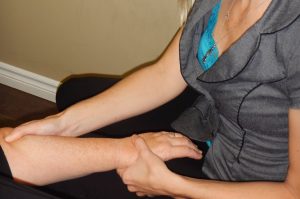Soft tissue therapy / myofascial release
STT or MRT is a form of manual therapy that focuses on treatment of the affected muscles, ligaments, tendons and fascia. STT/MRT helps to lengthen and stretch the affected tissue to allow for release of any adhesions or restrictions. The goal of this form of therapy is to help improve function by increasing range of motion, decreasing muscular hypertonicity, and reducing pain.
Common Reasons for Soft Tissue Injuries:
- Trauma
- Repetitive use
- Postural strain
- Improperly functioning joints
- Muscular Imbalances
STT/MRT is not appropriate for everyone, however some of the more common conditions where this form of therapy is beneficial can include:
- Neck pain
- Migraines
- Headaches
- Back pain
- Shoulder pain
- Plantar Fasciitis
- Carpal Tunnel Syndromes
Instrument Assisted Soft Tissue Mobilization
IASTM
What Is It?
IASTM is a specific form of therapy which uses an instrument made of high quality surgical stainless steel to diagnose and treat certain soft tissue dysfunctions. This form of treatment is thought to be originally derived from Traditional Chinese Medicine in the form of Gua Sha.
How It Works?
IASTM is used to detect areas of myofascial restrictions. This can include adhesions throughout large and small muscular regions, areas of scar tissue and fascial planes. Once detected the same instrument can be used to treat the adhesion through a variety of movements and sweeps. Research has shown that the use of IASTM helps to repair and regenerate collagen fibers and further breakdown any scar tissue, adhesions and fascial restrictions. In the end this form of treatment can help to decrease pain, increase function and improve range of motion
Is IASTM Always Required?
Not everyone will benefit from IASTM, but it can be helpful in a variety of conditions. Some of these include:
- Lateral Epicondylitis (Tennis Elbow)
- Carpal Tunnel Syndrome
- Medial Epicondylitis (Golfer’s Elbow)
- Various Regions of Tendinitis
- Muscle Strains
- Ligament Sprains
- Shin Splints
- Plantar Fasciitis
A thorough examination including a full health history and physical examination of the chief complaint will be performed before deciding if IASTM is right for you.
Description and Picture Courtesy of Tissue Tools
Reference:
Cheatham, S. W., Lee, M., Cain, M., & Baker, R. (2016). The efficacy of instrument assisted soft tissue mobilization: a systematic review. Journal of The Canadian Chiropractic Association, 60(3), 200-211.
Lukacs, C. (2013). Instrument-Assisted Soft-Tissue Mobilization Explained. ACA News (American Chiropractic Association), 9(8), 20-21.


